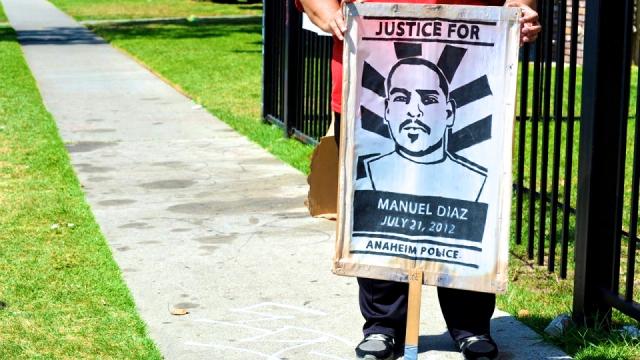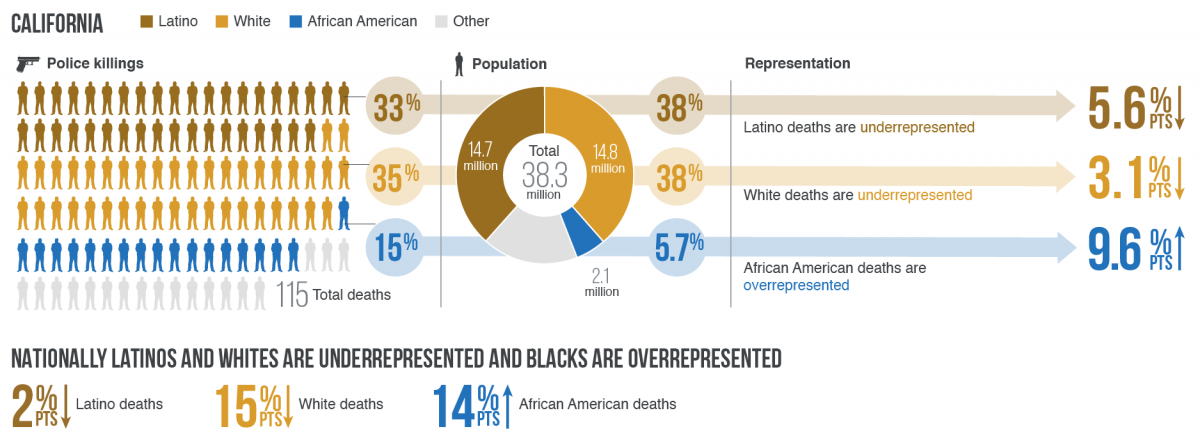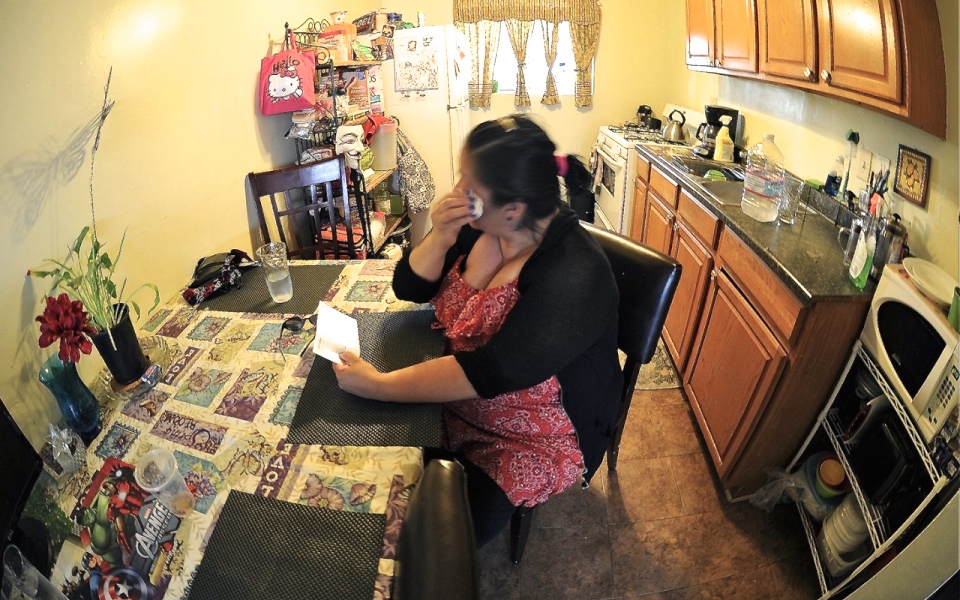
ANAHEIM, California — On July 21, 2012, police here killed Manuel Angel Diaz, an unarmed, 25-year-old man, when he ran away as officers approached. The next day, 21-year-old Joel Acevedo was killed by police after he allegedly fired shots at them.
Days of protests followed as hundreds took to the streets. Most were peaceful but rocks were thrown, store windows broken and cars vandalized. Police fired rubber bullets into the crowd.
The Anaheim riots received some national attention (pages A-11 and A-13 of The New York Times) but never reached the recent heights of similar events in Ferguson, Baltimore or Staten Island. Those protests sparked demonstrations in cities across the country and were covered around the clock by news networks, reviving the national dialogue over race relations.
Diaz and Acevedo are not household names. Michael Brown, Freddie Gray, Eric Garner are.
The obvious distinction: Diaz and Acevedo are Latinos, while the other victims of recent police incidents were African American.
The starkly different response to police shootings of minorities and deaths of minorities in police custody raises a question that is being asked more and more by activists and experts every day: Don’t brown lives matter, too?
But the reasons why the deaths of Latinos have not sparked the same national outrage as those of blacks are tangled in a complex web of history, debate over immigration and lack of government statistics on the number of brown lives lost at the hands of police.
“Police violence on African Americans hits a deeper resonant note because of our history,” said Mark Potok, senior fellow at the Southern Poverty Law Center, a non-profit that tracks hate crimes. “The oppression of African Americans goes right at the core of our history.”
The legacy of slavery and segregation fueled the civil rights movement and created a well-oiled organizing machine from national advocacy groups to black churches that continue to fight for the rights of African Americans.
“State-sanctioned murder of African Americans is an old powerful issue,” said Roberto Suro, director of the Tomas Rivera Policy Institute at the University of Southern California. “It isn’t a matter of these incidents alone sparking this outrage. It’s more than that. It’s symbolic of lynchings and other killings that have been an instrument of suppression in the past. These incidents gain force because they speak to a whole range of other considerations.”
Latino civil rights groups are more focused on immigration issues and lack a galvanizing figure such as the Rev. Al Sharpton who can mobilize protesters and attract inevitable media coverage in an instant.
“It’s a real problem beyond the issue of police abuse,” said Angelo Falcón, president of the National Institute for Latino Policy. “It’s a recurring complaint among Latino leaders. No matter how much people talk about how multicultural things are and how diverse they are, it seems to revert to black and white … How the hell do you break through that black-white way of looking at policy issues?”
In Anaheim, where more than half of the population of 345,000 is Hispanic, “there were at least seven killings (by police) between 2011 and 2012,” said Gabriel San Roman, a contributing writer for the alternative OC Weekly, who covers police brutality in Anaheim and throughout Orange County. Five were Latinos. Two more Latinos were wounded by police during that period, he said.
Three years after the deaths of Diaz and Acevedo, “there are no politicians, no advocacy organizations,” he said. “They’re not there anymore. It’s abysmal.” By contrast, large protests happened in Ferguson for the one-year anniversary of Michael Brown’s killing.
A memorial to the victims is still in place here on North Anna Drive, at the site where Diaz was shot. “Rest in Peace” and “Gone but not forgotten” signs hang on the gate outside an apartment complex. Every year, the anniversary gatherings attract fewer people (about 150 this year).
Diaz’ mother, Genevieve Huizar, sobs as she recounts the events of that day. “They shot him twice in the lower back as he was falling to his knees,” said Huizar, a state government worker for 19 years. “They said he had a gun in his right hand. It was his cell phone.”
Diaz had served time but had been out of jail and off probation, she said.
The Orange County District Attorney ruled both Diaz’ and Acevedo’s killings justified. Huizar lost a civil suit that charged police used excessive force. She’s appealing.
Her regrets are countless but the one that shouts her disappointment in the lack of public support for Latino police victims the loudest is this: In a press release she issued four days into the protests, she pleaded for peace and an end to the uprising. Now she thinks she was wrong. “I regret it with my whole being,” she said. “If there had been more of an uprising, there would maybe be no Ferguson, no Baltimore, no New York.”
What's in the Numbers
Part of the challenge of gaining rousing support for Latinos killed by police is the lack of data.
The U.S. government has a voluntary reporting system of people killed by law enforcement, broken down by race but not by ethnicity, which is the category that Hispanic is considered. Hispanics can be black, white or Asian but the Department of Justice does not separate them from the broader race categories.
“That’s one of the problems we have,” said Irastema Garza, policy consultant at the National Council of La Raza. “There’s no comprehensive database in terms of police deaths.” Former U.S. Attorney General Eric Holder called the lack of data “unacceptable.”
Al Jazeera America analyzed the best available statistics to gauge the rate of police killings of minorities in relation to their population. The analysis looks at U.S. Census Bureau population numbers and a crowdsourcing project launched by The Guardian after Ferguson that reports a daily tally of deaths by police of blacks, whites and Hispanics. The Guardian’s count is based on police reports, regional news, witness statements, research groups and open-source reporting projects.
Al Jazeera America’s research produced surprising findings: The percentage of Latino victims of police killings falls below their share of the population.
Hispanics make up almost 17 percent of the U.S. population but about 14 percent of police casualties. Blacks, by comparison, are about 12 percent of the U.S. population but 25 percent of police killings. Whites are 63 percent of the population but only 48 percent of police killings.
The disproportionate number of blacks who are killed by police is clear in the state data, as well. Blacks are more likely to be killed by police in numbers that exceed their presence in 30 states and the District of Columbia.
In contrast, the percentage of police killings of Latinos surpasses the Hispanic share of the population in just a handful of states. And in those eight states, including Alaska and Idaho, the killings were few (one in Alaska) and were disproportionate largely because the Latino population is tiny in those states. No Latinos were killed by police in more than half the states.
In California, where Latinos are 37 percent of the population, the number killed by police is below that share at 33 percent.
The share of killings of whites exceeded their population numbers in nine states.
The disproportionately high rate of black killings may partially explain the lack of media coverage of Latino deaths by police. But a study by Columbia University’s Center for the Study of Ethnicity and Race last year – titled The Latino Media Gap – found fault in the media’s approach to Latino coverage and said that Latino media participation is sorely lacking.
Stories about Latinos make up less than 1 percent of main news coverage and most were about Latino lawbreakers. As of 2013, there were no Latino anchors or executive producers in any of the nation’s top news programs. The study found that only 1.8 percent of news producers are Latinos.
The only reason the Anaheim killings received a modicum of attention outside California is because it is the home of Disneyland, San Roman said.
Based on The Guardian’s report, “up until June, 67 Latinos had been killed by police,” Garza said. “We’ve gotten very little coverage.”
She said that 58 percent of the victims didn’t have a weapon.
The Immigration Factor
The void in media coverage also ties into the absence of a national organizing movement — such as Black Lives Matter — among Latinos that focuses on protesting police abuse.
And that may come down to immigration.
Young black activists are behind Black Lives Matter, launched in 2013 after the acquittal of George Zimmerman in the shooting death of black teenager Trayvon Martin in Florida. After recent killings of young black men, local chapters kicked in to action across the country.
Young Latino activists have instead channeled their energy into the DREAMers movement that resulted in the DREAM Act (Development, Relief, and Education for Alien Minors) that provides conditional residency to immigrant minors who grew up in the U.S.
“We’ve always had pockets of activism but we didn’t have the numbers,” Garza said. “The Latino population has exploded. All of a sudden, the community has garnered attention vis a vis the election process.”
Latino demonstrations have targeted immigrant rights, deportations and conditions at detention facilities but not necessarily police killings of Hispanics.
“Immigration as an issue tends to suck all the air in the realm of Latino advocacy,” Potok said.
Large organizations such as the Mexican American Legal Defense and Educational Fund and La Raza have 11 million reasons – the estimated number of immigrants here illegally — to expend the bulk of their lobbying and advocacy work on protecting the rights of immigrants. Newer organizations — Mi Familia Vota, Latino Victory Project — have organized to boost Latino’s political clout through voter registration campaigns and get-out-the-vote efforts.
“We are up and coming and a force to reckon with,” Garza said. “Other social issues are perhaps not getting the same level of attention.”
That’s understandable, said Gregory C. Brown, associate professor of criminal justice at California State University, Fullerton, who teaches a class on minorities in the criminal justice system. “You have to pick and choose your battle,” he said “They have a lot of agendas and this one is probably on the back agenda.”
The Perception Factor
How Latinos are viewed and how Latinos view police also shape the dialogue.
Less than half of Hispanics say they have a great deal or fair amount of confidence in local police to treat Hispanics and whites equally, while 72 percent of whites say this, according to a Pew Research Center study last year. More than three-fourths of whites express confidence in police in their community to gain the trust of local residents, but only 51 percent of Hispanics and 45 percent of blacks say the same.
The distrust of police is even greater for Latino immigrants here illegally.
“There’s no question that the reporting of hate crimes against Latinos is significantly depressed because of the fear of being deported,” Potok said.
“There is this fear among Latinos of the police, especially if they’re undocumented,” Brown said. “They’re afraid of deportations … It takes a lot of gumption to go against the police if you have a language problem” and are here illegally.
Public perception of Latinos also tends to diffuse the outcry over police killings. “No matter how many are citizens, they’re still seen in the American mind as foreigners,” Falcón said. Diaz and Acevedo were third-generation Americans.
The Anaheim Police Department said it underwent a huge transformation since the 2012 protests. Two years later, Raul Quezada became the first Latino police chief in the city’s history. “We really did a critical self-assessment of the police department,” said Lt. Eric Trapp, public information officer. “We really needed to make some changes in our relations with the community.”
The city approved hiring more officers assigned to community policing and youth services. A Coffee with a Cop program was launched to hold informal meetings in neighborhoods across the city. A mobile Public Awareness Through Citizen Education unit now visits neighborhoods several times a year. A neighborhood advisory council was formed, use-of-force standards are posted on the police department’s website and officers are now equipped with body cams — the first in the region to invest in the cameras.
“We’ve got to go out there and be more engaged with the community,” Trapp said.
Signs of Rising Activism
Donna Acevedo, a vocational nurse who provides home health care, has been pushing for change and accountability since her son, Joel, was killed by police three years ago. “In 2012, everybody came out to say this is wrong. Everybody wanted to be in the limelight,” she said. “Then they went away. There’s no organization to fight against police brutality here. It’s random. It’s just me.”
Acevedo ran for City Council last year but because of dismal fundraising, garnered only about 4 percent of the vote. Plastered in white letters on the back window of her SUV are the words: F.T.P. Film The Police.
Huizar proudly wears a red T-shirt emblazoned with the Young Survivors Legacy Support Network logo. She formed the group to support families who have lost loved ones at the hands of police. The group proclaims: “We are not against police. We are against police violence.”
Organizers have traveled the state to meet with survivors of police killings. Huizar and others organize monthly picnics for neighborhood children. Huizar even reached out to Trayvon Martin’s mother but never heard back.
“Black lives matter. When they say that, they mean all lives,” she said. “We need to make people aware.”
Awareness is rising, Garza said. At La Raza’s recent national conference in Kansas City, Missouri, participants shared stories of police abuse. “It was absolutely packed,” she said. “We know that the Latino community is very interested because racial profiling continues to be widespread. … If Latinos are invisible nationally in the public eye, we may be invisible when they’re making policy.”
3 WAYS TO SHOW YOUR SUPPORT
- Log in to post comments














